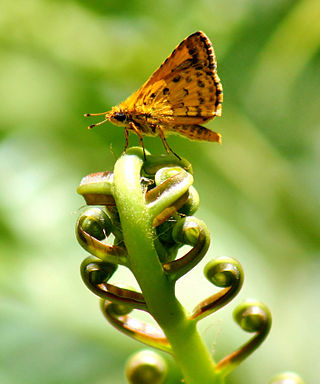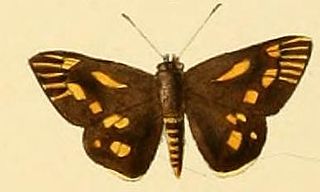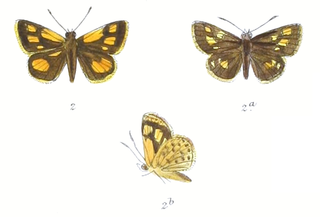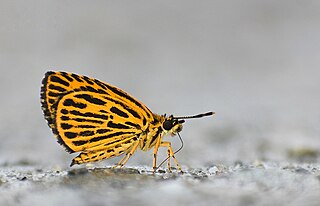
Pedanius Dioscorides, “the father of pharmacognosy”, was a Greek physician, pharmacologist, botanist, and author of De materia medica —a 5-volume Greek encyclopedia about herbal medicine and related medicinal substances, that was widely read for more than 1,500 years. For almost two millennia Dioscorides was regarded as the most prominent writer on plants and plant drugs.

Ampittia dioscorides, the common bush hopper or simply bush hopper, is a species of butterfly found in India, China, Indochina, Cambodia and on to Borneo, Sumatra and Java belonging to the family Hesperiidae.

Ampittia is the genus of bush hoppers in the skipper butterfly family, Hesperiidae. It is the only member of the tribe Ampittiini.

Kedestes is a genus of skippers in the family Hesperiidae, commonly known as rangers. The genus is restricted to the Afrotropical realm, where it occurs mostly in the East and South. The larvae of several species feed on grasses. It is thought to be related to Ampittia.

Ampittia capenas, the riverine ranger or African bush hopper, is a species of butterfly in the family Hesperiidae.
Ampittia kilombero is a species of butterfly in the family Hesperiidae. It is found in the Kilombero Valley, Tanzania.
Ampittia parva is a species of butterfly in the family Hesperiidae. It is found in north-eastern Tanzania, including Zanzibar.

Ampittia dalailama is a species of butterfly in the family Hesperiidae. It was described by Paul Mabille in 1876. It is found in Tibet and western China. Hindwing beneath brown, densely dusted with yellow scales, with three yellow spots near the base and a postmedian as well as a subterminal row of yellow dots; the postmedian spots of cellules 3 and 4 are placed near the centre of these cellules and cover their whole breadth.

Ampittia maroides is a species of butterfly in the family Hesperiidae. It was described by Lionel de Nicéville in 1896. It is found in Burma, Thailand and Laos.

Ampittia nanus is a species of butterfly in the family Hesperiidae. It was described by John Henry Leech in 1890. It is found in China. One of the two marginal rows of spots of the forewing in cellules 5, 6 and 7, or 6, 7 and 8, the other in cellule 2 and 3: no light spot in cellule 4. A spot in the cell near the upper angle ash colour.
Ampittia sichunanensis is a species of butterfly in the family Hesperiidae. It was described by Z.G. Wang and Y. Niu in 2002. It is found in China (Eimashan).
Ampittia tristella is a butterfly in the family Hesperiidae. It was described by Shou, Chou and Li in 2006. It is found in China.

Ampittia virgata is a species of butterfly in the family Hesperiidae. It was described by John Henry Leech in 1890. It is found in China and Taiwan. Its wingspan is 30–32 mm. Cell of forewing beneath yellow with a black streak in the centre.
Andronymus fontainei is a butterfly in the family Hesperiidae. It is found in the Democratic Republic of the Congo and is possibly endemic to the Albertine Rift.
Chondrolepis ducarmei is a butterfly in the family Hesperiidae. It is found in the Democratic Republic of the Congo and is endemic to the Albertine Rift. The habitat consists of submontane areas.
Chondrolepis uluguru is a butterfly in the family Hesperiidae. It is found in Tanzania. The habitat consists of submontane areas.

Ochus subvittatus, the tiger hopper, is the only species in the monotypic moth genus Ochus of the family Hesperiidae. The genus was erected by Lionel de Nicéville in 1894. The species was first described by Frederic Moore in 1878. It is found in the Khasi Hills and Naga Hills of India, Myanmar, Thailand, Laos, Vietnam and Yunnan.










